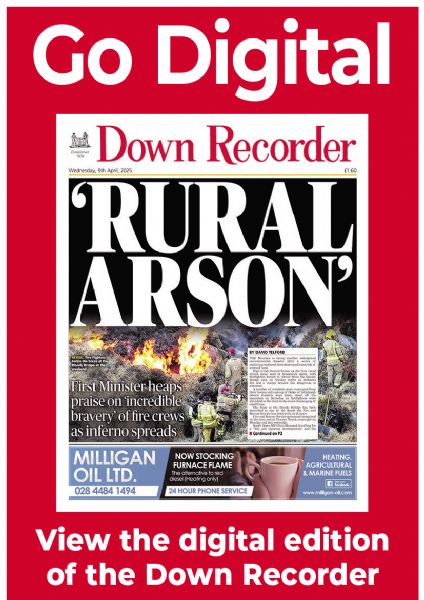‘Absolutely delighted’ rail bus finds new home in Wales
‘Absolutely delighted’ rail bus finds new home in Wales
18 June 2025
THE Downpatrick and Co Down Railway has said farewell to a rare, experimental rail bus after more almost a quarter of a century at its Market Street base in the town.
The RB3 has crossed the Irish Sea by ferry to begin life the Gwendraeth Valley Railway in Carmarthenshire.
It was originally built in 1981 by British Rail Engineering Limited as one of four experimental lightweight rail buses designed to serve lightly used rural lines.
The so-called RB3 spent the early part of its life in England and Northern Ireland, originally on the Coleraine-Portrush line and on display at the Ulster Folk and Transport Museum, before arriving in Downpatrick in 2001.
Following a long period out of use, it has now been donated to a new heritage line that perfectly suits its unique dimensions and capabilities.
Railway chairman, Robert Gardiner, said the RB3 was always an “unusual and significant piece of railway heritage” but one that sadly didn’t quite fit the local railway’s future plans.
The vehicle was initially transferred to Downpatrick, initially on loan from Northern Ireland Railways and it was hoped RB3 could provide midweek services for the volunteer-run line which, at the time, lacked the resources for full-size train operation outside weekends.
Although trialled on the line, the RB3 saw only limited use due to reliability issues and practical constraints and it was later retired from active use, but preserved under cover as part of the collection.
The RB3 remained at Downpatrick for 24 years, where it was kept
intact and complete. In 2023, the local railway undertook a rolling stock review, leading to a call for expressions of interest from other museums and railways.
Mr Gardiner explained that with its limited capacity “it was never going to be a high priority” for restoration in Downpatrick.
“But we are absolutely delighted that it’s found a home where it’s needed at the Gwendraeth Valley Railway,” he said.
The West Wales heritage railway, which is developing along part of the historic Burry Port and Gwendraeth Valley line, faces structural limitations such as low bridges, making traditional mainline stock impractical.
But the RB3’s compact design makes it an ideal fit, alongside other modified vehicles such as ‘cut-down’ Class 08 locomotives.
Cymdeithas Rheilffordd Gwendraeth Railway Society chairman, Stuart Thomas, said it was an “absolute pleasure” to work with the Downpatrick team to bring RB3 to Wales.
“Its narrow and low profile suits our railway’s restricted gauge perfectly, and we see it as a fitting modern continuation of Colonel Holman F Stephens’s early rail bus innovations on rural lines,” he explained.
“We’re incredibly grateful to the Downpatrick and Co Down Railway for its generosity, not just the vehicle, but also the crates of drawings, spares and even moquette to help us with its restoration.”
The transfer of the vehicle involved over a year of logistical planning and was carried out in coordination with another major heritage railway transport operation involving the Irish Traction Group.
The RB3 was loaded onto a ferry as a backload after ITG’s General Motors loco 152 was delivered to Downpatrick, making efficient use of available transport resources.
On Sunday, June 8, the vehicle was shunted for the last time through the Downpatrick workshop and Carriage Gallery, with many volunteers taking “one last trip” on it, before being winched onto a trailer and beginning its journey to a temporary storage site in England ahead of work starting.
The RB3’s departure was described by Mr Gardiner as bittersweet.”
He added: ”We’re proud to have cared for RB3 over the years and grateful for its role in our history. But it’s even better to see it going somewhere it can be useful again, and where people will be able to ride on it one day.”
Restoration work will include reguaging the vehicle back to British standard gauge, mechanical overhaul, minor bodywork repairs and a full interior and exterior refurbishment.
With many of RB3’s components shared with the Leyland National Bus, and the later ‘Pacer’ railcars that were derived from the design, the Gwendraeth Valley Railway hopes to draw on the UK bus preservation community for additional support.
The local railway wishes the team in Wales every success with its ambitious plans and looks forward to seeing RB3 back in service in the years to come.


